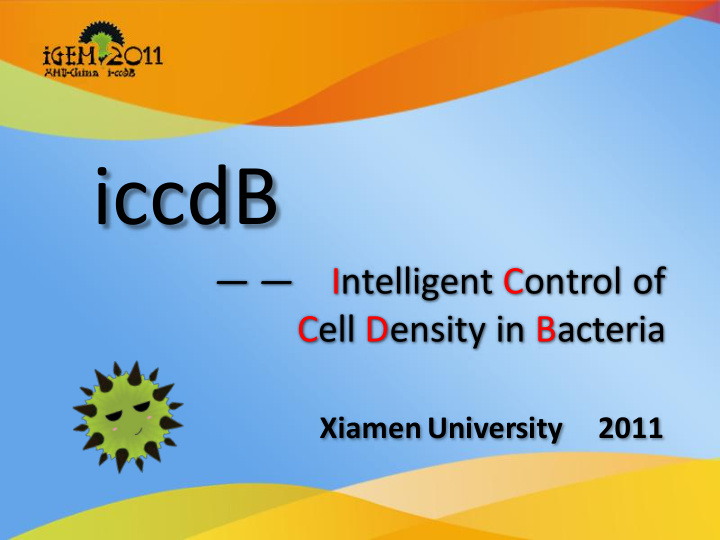



iccdB — — Intelligent Control of Cell Density in Bacteria Xiamen University 2011
Our Team • 9 Undergraduates • 3 Advisors
Inspiration Pu’er Tea Fermentation
iccdB A bacteria population-control device — — Intelligent Control of Cell Density in Bacteria
Mechanism LuxR Producer LuxI Producer CcdB Producer
Mechanism an acyl-[acp] a holo-[acp] + s-adenosyl-L-methionine AHL s-methyl-5'-thioadenosine IPTG AHL LuxR LuxR LuxI CcdB lacZ α -ccdB lacl+pL luxI lacl+pL luxR lux pR
Mechanism IPTG AHL LuxR LuxI CcdB LuxR lacZ α -ccdB lacl+pL luxI lacl+pL luxR lux pR
Mechanism CcdB Gyrase
Mechanism CcdB- Gyrase Complex
Performance • Bacteria population control devices 24h 32h
Performance A series of bacteria population control devices based on RBSes Mutation of promoter lux pR Influence of iccdB on expression of downstream genes
Performance “Can we generate a series of devices that program bacteria population maintain at different cell densities? ”
Performance • Different RBSes Cell Growth Column Graph 20.00 Colony-Forming Units /mL -1 X10 -8 18.00 16.00 14.7 14.00 12.00 CcdB 10.00 6.92 8.00 6.00 4.45 4.00 2.53 1.68 2.00 lacZ α -ccdB lux pR 0.00 RBS 0.07 RBS 0.3 BL21 iccdB0.07 iccdB0.3 iccdB0.6 iccdB1.0 RBS 0.6 RBS 1.0 Devices
Modeling
Performance “What else? ”
Performance • Mutations of lux pR —— Expression efficiency IPTG AHL EGFP gfp luxI luxR lux pR
• Mutations of lux pR —— Expression efficiency ACCTGTAGG gfp lux pR ACCTGTAGG gfp lux pR ACCTGTAGG gfp lux pR
• Mutations of lux pR —— Expression efficiency AC TGTAGG T Promoters Strength Relative to lux pR-3 (BBa_K658006) gfp lux pR - 3 120.00 100.00 100.00 Efficiency /% ACCT TAGG C 80.00 56.54 60.00 40.00 lux pR - 5 gfp 11.89 20.00 6.02 0.00 lux pR-5 lux pR-3 lux pR lux pR-3/5 T C AC T TAGG Devices gfp
Performance • Mutations of lux pR —— iccdB-X Cell Growth Column Graph 3.5 Colony-Forming Units / mL -1 3 2.53 2.5 X10 -8 2 1.51 1.5 CcdB 1 EGFP 0.5 0 iccdB-3 iccdB0.6 Devices lacZ α -ccdB lux pR-3
Performance • Influence of iccdB on downstream genes Fluorescence of Different Devices 1800 1602.4 1600 1400 Fluorescence 1203.1 1200 1000 800 600 400 200 0 GFP iccdB-GFP iccdB0.6 lacl+pL gfp Devices
Future Plan Induced by IPTG ccdB luxI luxR coding
Summary Designed and characterized a series of bacteria population-control devices. Improved the strength of promoter lux pR by site- directed mutagenesis. Characterized the efficiency of promters lux pR and its 3 mutants. Designed and characterized the device iccdB-GFP to test the influence of iccdB on downstream genes.
Scientific Achievement
Human Practice Open lab day for kids Biosafety lecture
Open lab day for kids • 20 kids from Yan Wu primary school • Exhibition about microorganism • Lecture about synthetic biology • Basic experiment
Biosafety lecture Top questions 8% 3% 45% 18% 26% Genetically modified foods Majors Artificial microorganism Arts 8% Economics Bio-leakage from laboratory 25% Lingusitic 25% Threat of Human Genome Project on Chemistry Human rights 27% Management Others 10% Others 5%
Reference [1] Kempner E, Hanson F. Aspects of light production by Photobacterium fischeri [J]. Journal of Bacteriology, 1968, 95(3): 975-979. [2] Nealson KH, Platt T, Hastings J. Cellular control of the synthesis and activity of the bacterial luminescent system[J]. Journal of Bacteriology, 1970, 104(1): 313-322. [3] Fuqua WC, Winan SC, Greenberg E. Quorum sensing in bacteria: the luxR-luxI family of cell density-responsive transcriptional regulators[J]. Journal of Bacteriology, 1994, 176(2): 269-275. [4] Eberhard A, Burlingame AL, Eberhard C, Kenyon GL, Nealson KH, Oppenheimer NJ. Structural identification of autoinducer of Photobacterium fischeri luciferase[J]. Biochemistry, 1981, 20(9): 2444-2449. [5] Engebrecht J, Nealson KH, Silverman M. Bacterial bioluminescence: isolation and genetic analysis of functions from Vibrio fischeri [J]. Cell, 1983. 32(3): 773-781. [6] Ruby EG, Nealson KH. Symbiotic association of Photobacterium fischeri with the marine luminous fish Monocentris japonica : a model of symbiosis based on bacterial studies[J]. The Biological Bulletin, 1976, 151(3): 574-586.
[7] Ruby EG, McFall-Ngai MJ. Oxygen-utilizing reactions and symbiotic colonization of the squid light organ by Vibrio fischeri [J]. Trends in Microbiology, 1999, 7(10): 414-420. [8] Kaplan HB, Greenberg E. Diffusion of autoinducer is involved in regulation of the Vibrio fischeri luminescence system[J]. Journal of Bacteriology, 1985, 163(3): 1210-1214. [9] http://www.che.caltech.edu/groups/fha/quorum.html [10] Baldwin T, Devine JH, Heckel, RC, Lin, JW, Shadel GS. The complete nucleotide sequence of the lux regulon of Vibrio fischeri and the luxABN region of Photobacterium leiognathi and the mechanism of control of bacterial bioluminescence[J]. Journal of Bioluminescence and Chemiluminescence, 1989, 4(1): 326-341. [11] Meighen EA. Enzymes and genes from the lux operons of bioluminescent bacteria[J]. Annual Reviews in Microbiology, 1988, 42(1): 151-176. [12] You L, Cox RS, Weiss R, Arnold FH. Programmed population control by cell-cell communication and regulated killing[J]. Nature, 2004, 428(6985): 868-871. [13] Kampranis SC, Howells AJ, Maxwell A. The interaction of DNA gyrase with the bacterialtoxin CcdB: evidence for the existence of two gyrase-CcdB complexes[J]. Journal of Molecular Biology, 1999, 293(3): 733-744.
Acknowledgements Steve Jobs
Thank you
Recommend
More recommend